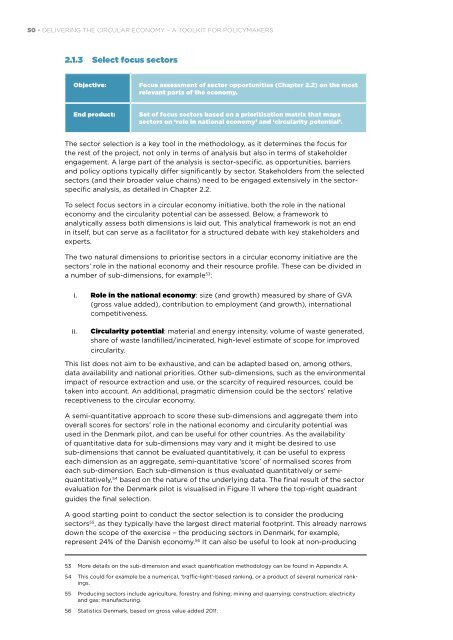DELIVERING THE CIRCULAR ECONOMY A TOOLKIT FOR POLICYMAKERS
20150924_Policymakers-Toolkit_Active-links
20150924_Policymakers-Toolkit_Active-links
Create successful ePaper yourself
Turn your PDF publications into a flip-book with our unique Google optimized e-Paper software.
50 • <strong>DELIVERING</strong> <strong>THE</strong> <strong>CIRCULAR</strong> <strong>ECONOMY</strong> – A <strong>TOOLKIT</strong> <strong>FOR</strong> <strong>POLICYMAKERS</strong><br />
2.1.3 Select focus sectors<br />
Objective:<br />
Focus assessment of sector opportunities (Chapter 2.2) on the most<br />
relevant parts of the economy.<br />
End product:<br />
Set of focus sectors based on a prioritisation matrix that maps<br />
sectors on ‘role in national economy’ and ‘circularity potential’.<br />
The sector selection is a key tool in the methodology, as it determines the focus for<br />
the rest of the project, not only in terms of analysis but also in terms of stakeholder<br />
engagement. A large part of the analysis is sector-specific, as opportunities, barriers<br />
and policy options typically differ significantly by sector. Stakeholders from the selected<br />
sectors (and their broader value chains) need to be engaged extensively in the sectorspecific<br />
analysis, as detailed in Chapter 2.2.<br />
To select focus sectors in a circular economy initiative, both the role in the national<br />
economy and the circularity potential can be assessed. Below, a framework to<br />
analytically assess both dimensions is laid out. This analytical framework is not an end<br />
in itself, but can serve as a facilitator for a structured debate with key stakeholders and<br />
experts.<br />
The two natural dimensions to prioritise sectors in a circular economy initiative are the<br />
sectors’ role in the national economy and their resource profile. These can be divided in<br />
a number of sub-dimensions, for example 53 :<br />
i. Role in the national economy: size (and growth) measured by share of GVA<br />
(gross value added), contribution to employment (and growth), international<br />
competitiveness.<br />
ii.<br />
Circularity potential: material and energy intensity, volume of waste generated,<br />
share of waste landfilled/incinerated, high-level estimate of scope for improved<br />
circularity.<br />
This list does not aim to be exhaustive, and can be adapted based on, among others,<br />
data availability and national priorities. Other sub-dimensions, such as the environmental<br />
impact of resource extraction and use, or the scarcity of required resources, could be<br />
taken into account. An additional, pragmatic dimension could be the sectors’ relative<br />
receptiveness to the circular economy.<br />
A semi-quantitative approach to score these sub-dimensions and aggregate them into<br />
overall scores for sectors’ role in the national economy and circularity potential was<br />
used in the Denmark pilot, and can be useful for other countries. As the availability<br />
of quantitative data for sub-dimensions may vary and it might be desired to use<br />
sub-dimensions that cannot be evaluated quantitatively, it can be useful to express<br />
each dimension as an aggregate, semi-quantitative ‘score’ of normalised scores from<br />
each sub-dimension. Each sub-dimension is thus evaluated quantitatively or semiquantitatively,<br />
54 based on the nature of the underlying data. The final result of the sector<br />
evaluation for the Denmark pilot is visualised in Figure 11 where the top-right quadrant<br />
guides the final selection.<br />
A good starting point to conduct the sector selection is to consider the producing<br />
sectors 55 , as they typically have the largest direct material footprint. This already narrows<br />
down the scope of the exercise – the producing sectors in Denmark, for example,<br />
represent 24% of the Danish economy. 56 It can also be useful to look at non-producing<br />
53 More details on the sub-dimension and exact quantification methodology can be found in Appendix A.<br />
54 This could for example be a numerical, ‘traffic-light’-based ranking, or a product of several numerical rankings.<br />
55 Producing sectors include agriculture, forestry and fishing; mining and quarrying; construction; electricity<br />
and gas; manufacturing.<br />
56 Statistics Denmark, based on gross value added 2011.



